Abstract
Past research on democracy and politicalcorruption produced mixed results becauseof differences in sampling and analyticalmethods. Moreover, an important shortcominghas been researchers' focus on detectinglinear effects alone. In the current study,I statistically controlled for potentiallyconfounding economic factors and usedhierarchical polynomial regression toevaluate the form of thedemocracy-corruption relationship. Resultsshowed that a cubic function best fittedthe data. Despite eruptions of corruptionamong intermediate democracies, theconsolidation of advanced democraticinstitutions eventually reduced corruption.Ultimately, the initial politicalconditions and the final democraticachievements determined the magnitude ofpolitical corruption in a country.
Similar content being viewed by others
References
Agresti, A. and B. Finlay, Statistical Methods for the Social Sciences, 3rd edn. (Upper Saddle River, NJ: Prentice Hall, 1997).
Barro, R.J., Determinants of Economic Growth: A Cross-Country Empirical Study (Cambridge, MA: The MIT Press, 1997).
Beck, N. and J. Katz, “What to Do (and not to Do) with Times-Series Cross-Section Data,” American Political Science Review 1995 (89), 634-647.
Boix, C., “Democracy, Development, and the Public Sector,” American Journal of Political Science 2001 (45), 1-17.
Bunce, V., “Comparative Democratization: Big and Bounded Generalizations,” Comparative Political Studies 2000 (33), 703-734.
Burkhart, R.E., “Comparative Democracy and Income Distribution: Shape and Direction of the Causal Arrow,” Journal of Politics 1997 (59), 148-164.
Cohen, A., Crime and Corruption in Eurasia: A Threat to Democracy and International Security (Washington, DC: The Heritage Foundation, 1995).
da Silva, C.E.L., “Journalism and Corruption in Brazil,” in J.S. Tulchin and R.H. Espach (eds.), Combating Corruption in Latin America (Washington, DC: Woodrow Wilson Center Press, 2000) pp. 173-192.
della Porta, D. and A. Vannucci, Corrupt Exchanges: Actors, Resources, and Mechanisms of Political Corruption (New York: Aldine de Gruyter, 1999).
Fairbanks, C.H., Jr., “Disillusionment in the Caucasus and Central Asia,” Journal of Democracy 2001 (12), 49-56.
Frey, B.S. and A. Stutzer, “Happiness, Economy and Institutions,” The Economic Journal 2001 (110), 918-938.
Giglioli, P.P., “Political Corruption and the Media: The Tangentopoli Affair,” International Social Science Journal 1996 (48), 381-394.
Goldsmith, A.A., “Democracy, Property Rights, and Economic Growth,” Journal of Development Studies 1995 (32), 157-174.
Goldsmith, A.A., “Slapping the Grasping Hand: Correlates of Political Corruption in Emerging Markets,” American Journal of Economics and Sociology 1999 (58), 865-883.
Harris-White, B. and G. White (eds.), Liberalization and New Forms of Corruption (Brighton: Institute of Development Studies, 1996).
Hegre, H., T. Ellingsen and S. Gates, “Toward a Democratic Civil Peace? Democracy, Political Change, and Civil War, 1816-1992,” American Political Science Review 2001 (95), 33-48.
International Monetary Fund, “The World Economic Outlook Database April 2002,” [On-line database]. 2002, Available http://www.imf.org/external/pubs/ft/weo/2002/01/data/index.htm
Jamieson, A., The Antimafia: Italy's Fight against Organized Crime (New York: Palgrave MacMillan, 2000).
Johnston, M., “Public Officials, Private Interests, and Sustainable Democracy: When Politics and Corruption Meet,” in K.A. Elliot (ed.), Corruption and the Global Economy (Washington, DC: Institute for International Economics, 1997) pp. 61-82.
Karatnycky, A. (ed.), Freedom in the World: The Annual Survey of Political Rights and Civil Liberties, 2000-2001 (Somerset, NJ: Transaction, 2001).
Little,W., “Corruption and Democracy in Latin America,” IDS Bulletin 1996 (27), 64-70.
Marquette, H., “Corruption, Democracy and theWorld Bank,” Crime, Law and Social Change 2001 (36), 395-407.
Mbaku, J.M., “Post-Independence Opportunism and Democratization in Africa,” Journal of Social, Political and Economic Studies 1995 (20), 405-422.
Montinola, G.R. and R.W. Jackman, “Sources of Corruption: A Cross-National Study,” British Journal of Political Science 2002 (32), 147-170.
Moran, J., “Democratic Transitions and Forms of Corruption,” Crime, Law and Social Change 2001 (36), 379-393.
Rodrik, D., “Democracies Pay Higher Wages,” Quarterly Journal of Economics 1999 (114), 707-738.
Rose-Ackerman, S., Corruption and Government: Causes, Consequences, and Reform (New York: Cambridge University Press, 1999).
Sandholtz, W. and W. Koetzle, “Accounting for Corruption: Economic Structure, Democracy, and Trade,” International Studies Quarterly 2000 (44), 31-50.
Sayrs, L.W., Pooled Time Series Analysis, Quantitative Applications in the Social Sciences No 70 (Thousand Oaks, CA: Sage, 1989).
Schwartz, H., “Surprising Success: The New Eastern European Constitutional Courts,” in A. Scheller, L. Diamond and M.F. Plattner (eds.), The Self-Restraining State: Power and Accountability in New Democracies (Boulder, CO: Lynne Rienner Publishers, 1999) pp. 195-214.
The Economist Intelligence Unit, EIU Country Data [On-line database]. 2001, Available http://www.a1.secure.alacra.com/cgi-bin/eiu.exe?app=eiu&msg=DisplayContent&topic=datatype&product=17
Transparency International, Corruption Perceptions Index [On-line database]. 2002, Available http://www.transparency.org/surveys/index.html#bpi.
Treisman, D., “The Causes of Corruption: A Cross-National Study,” Journal of Public Economics 2000 (76), 399-457.
Van Rijckeghem, C. and B. Weder, “Bureaucratic Corruption and the Rate of Temptation: Do Wages in the Civil Service affect Corruption, and by how Much?” Journal of Development Economics 2001 (65), 307-331.
Weyland, K., “The Politics of Corruption in Latin America,” Journal of Democracy 1998 (9), 108-121.
Author information
Authors and Affiliations
Rights and permissions
About this article
Cite this article
Sung, HE. Democracy and political corruption: A cross-national comparison. Crime, Law and Social Change 41, 179–193 (2004). https://doi.org/10.1023/B:CRIS.0000016225.75792.02
Issue Date:
DOI: https://doi.org/10.1023/B:CRIS.0000016225.75792.02




